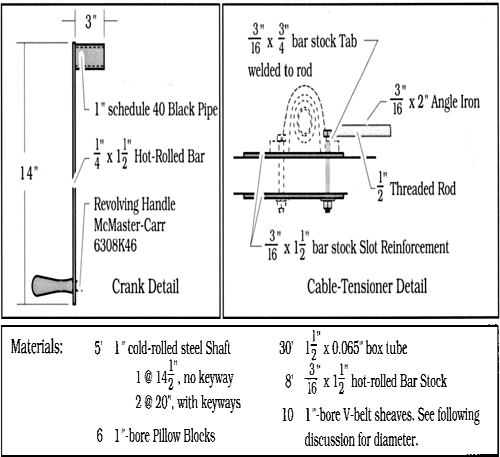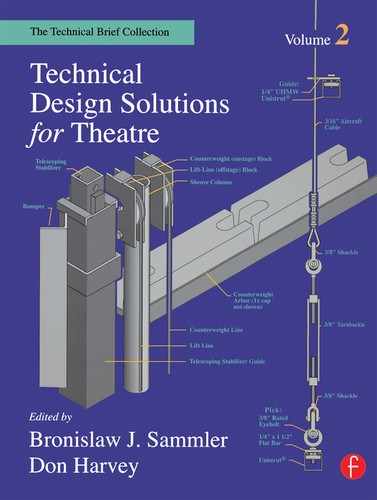Alan Hendrickson |
A Hand-Driven Endless-Loop Turntable Drive |
One person turning a handcrank can easily move a lightly loaded turntable, and a turntable driven by an endless-loop cable can rotate clockwise or counterclockwise any number of times. The device described here embodies both of those principles in a simple, inexpensive turntable drive.
SYSTEM COMPONENTS
The welded tube steel drive frame shown in Figure 1 holds a handcrank about 3 feet off the floor, a comfortable working height for most people. With this frame, a stagehand might typically be expected to turn a foot-long handcrank at about 60 to 90 rpm.
To allow the use of a simplified endless loop, all the sheaves in the drive frame are standard cast-iron A-size V-belt sheaves. In most endless loops, the ends of a piece of wire rope are joined in a long splice. In this one, the ends are simply Nicopressed together. The swages travel easily, if a bit inelegantly, through the large grooves of the V-belt sheaves. These sheaves’ groove profile is hard on the wire-rope loop, but most productions will come and go long before the loop needs replacing.
The cable tensioner (detailed in Figure 2 along with a handcrank) can move the handcrank-shaft’s pillow blocks back and forth to adjust cable tension: and the two muling sheaves, those on the lowest shaft, can be moved up and down to adjust the drive loop’s height off the floor.
The muling sheaves must be free to spin in opposite directions because of the way the loop serves into the frame, and the four idler sheaves may be left unkeyed. But the four drive sheaves on the handcrank shaft must be keyed in place in order to increase the wrap friction on which this system relies.

FIGURE 1: THE DRIVE FRAME
MULTIPLYING USEFUL FFUCTION
Many things — rope cleats, capstan winches, and clove-hitches, for instance — rely on multiple-wrap friction to hold a load. In turntable drives too, a little more wrap means a lot less chance of slipping. In fact, increasing the amount of wrap between cable and turntable, and between cable and driving sheaves exponentially increases the effects of friction and decreases the likelihood of slipping. Figure 3 schematically illustrates how wrap is maximized with this system.

FIGURE 2: HANDCRANK AND CABLE TENSIONER DETAILS

FIGURE 3: AUGMENTING FRICTION WITH A MULTI-SHEAVE ENDLESS-LOOP DRIVE
CALCULATING DRIVE SHEAVE DIAMETER
Estimating how fast a turntable must spin is essential in determining drive sheave diameter. One estimate of top rotational speed comes from consideration of edge speed, or the linear speed at the edge of a turntable:
rpm = (9.55 × edge speed) ÷ radius
where: rpm = top rotational speed of the turntable (rev per min) edge speed = top linear speed at turntable edge (ft per sec) radius = (ft)
If an actor must move gracefully onto or off of a moving turntable, edge speeds must be limited accordingly. A stroll covers about 1.5 ft/sec; a brisk walk, about 3 ft/sec.
Another estimate of the top rotational speed relates the needed degree of rotation to the amount of time available, for example, a 180° turn in 14 seconds:
rpm = (0.333 × degrees) ÷ time
where: rpm = top rotational speed of the turntable (rev per min) degrees = total turn from start to finish (deg) time = total time taken for move from start to finish (sec)
This formula assumes that half the time for the move will be spent in acceleration and half in deceleration — the gentlest type of move possible to accomplish the rotation in time. Faster acceleration and deceleration would permit reducing the top rpm by as much as half.
The total reduction ratio between power source and turntable is:
ratio = rpm source ÷ rpm turntable
where: ratio = reduction ratio (unitless)
rpm source = top rotational speed of the power source — usually a motor or handcrank — (rev per min)
rpm turntable = top rotational speed of the turntable, as obtained from the formulas above (rev per min)
Example: A person turning a handcrank at 60 rpm is driving a turntable 20 ft in diameter to a top edge speed of 1.5 ft/sec. What diameter are the driver sheaves?
| Solution: First find the top speed of the turntable: | rpm = (9.55 × edge speed) ÷ radius |
| rpm = (9.55 × 1.5) ÷ 10 = 1.43 rev per min | |
| Now calculate the reduction ratio: | ratio = rpm source ÷ rpm turntable |
| ratio = 60 ÷ 1.43 = 42.0 (or “42:1” or “42 to 1”) | |
| The ratio of turntable diameter to driving sheave diameter equals the total reduction ratio, so: | ratio = turntable dia ÷ driving sheave dia |
| 42 = 20 ÷ driving sheave dia driving sheave dia = 0.48′ (or 5¾″) |
